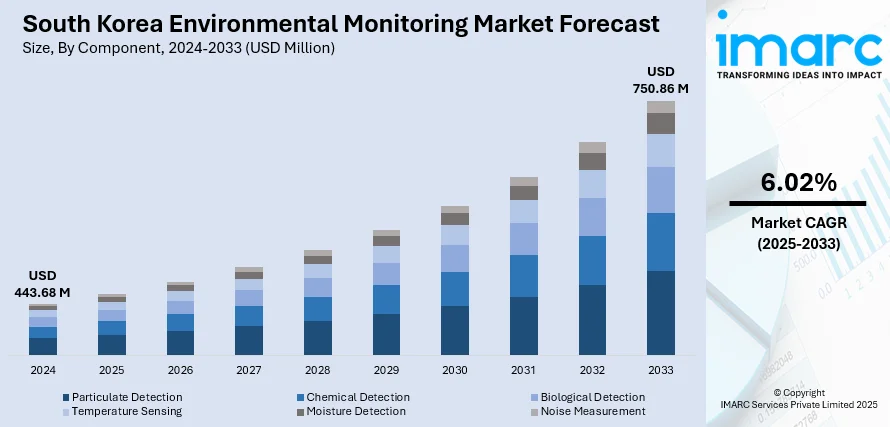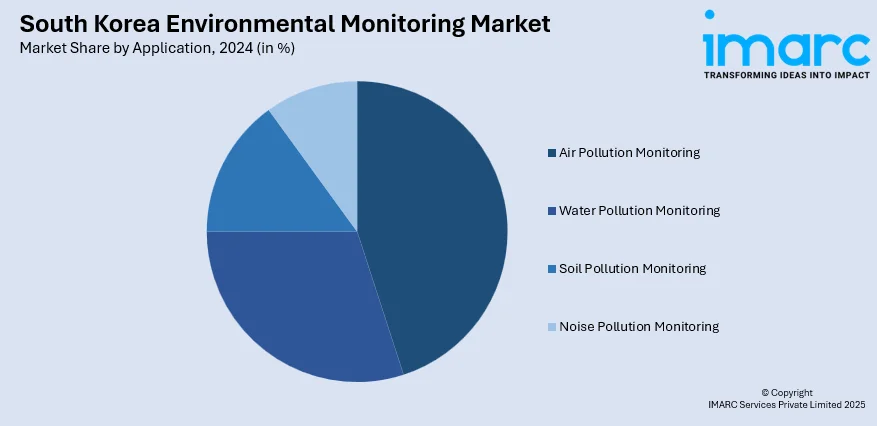
South Korea Environmental Monitoring Market Size, Share, Trends and Forecast by Component, Product Type, Sampling Method, Application, and Region, 2025-2033
South Korea Environmental Monitoring Market Overview:
The South Korea environmental monitoring market size reached USD 443.68 Million in 2024. Looking forward, IMARC Group expects the market to reach USD 750.86 Million by 2033, exhibiting a growth rate (CAGR) of 6.02% during 2025-2033. Increasingly stringent government regulations for pollution control (air, water, soil), rising public awareness of environmental issues, and significant technological advancements like IoT, AI, and real-time analytics for more efficient monitoring are some of the factors contributing to South Korea environmental monitoring market share.
|
Report Attribute
|
Key Statistics
|
|---|---|
|
Base Year
|
2024
|
|
Forecast Years
|
2025-2033
|
|
Historical Years
|
2019-2024
|
| Market Size in 2024 | USD 443.68 Million |
| Market Forecast in 2033 | USD 750.86 Million |
| Market Growth Rate 2025-2033 | 6.02% |
South Korea Environmental Monitoring Market Trends:
Next-Generation Remote Sensing for National Resilience
A significant shift is underway in how nations enhance their environmental monitoring capabilities. Countries are increasingly investing in advanced orbital platforms, specifically designed to gather high-resolution data for critical sectors. This development aims to bolster national defenses against the escalating challenges posed by extreme weather and to fortify essential resources. The deployment of such sophisticated space-based assets provides invaluable information for precise resource management and proactive disaster preparedness, signifying a deepened commitment to leveraging innovative technology for ecological stability and strengthened national oversight. This progression enables improved predictive power and faster responses to evolving environmental dynamics. These factors are intensifying the South Korea environmental monitoring market growth. For example, in June 2025, South Korea announced plans to launch a specialized agricultural satellite in 2026, marking a significant advancement in its environmental monitoring capabilities. This strategic initiative is designed to bolster the nation's response to climate-related disasters and enhance food security. The satellite would provide critical data for precise agricultural monitoring and effective food supply management, reinforcing South Korea's commitment to utilizing cutting-edge space technology for environmental resilience and strengthening its environmental monitoring market. This development is set to improve the country's foresight and reaction to increasingly extreme weather patterns.

To get more information on this market, Request Sample
Accelerated Environmental Stewardship
A robust dedication to environmental improvement is reshaping national priorities. Significant strides in mitigating air pollution, evidenced by a dramatic reduction in poor air quality days and particulate matter, highlight the effectiveness of comprehensive national strategies. These ambitious commitments, emphasizing clean air and intelligent industrial solutions, are consequently spurring a heightened demand for sophisticated environmental oversight tools. This includes a growing need for real-time sensing capabilities, advanced data analysis platforms, and smart resource management systems. Such proactive governmental approaches, coupled with rising public awareness, are positioning this nation as a dynamic hub and an attractive destination for innovative environmental solutions. For instance, in February 2025, South Korea improved its air quality, reducing "poor air days" from 60 to just 10 annually and achieving a 38% reduction in PM2.5 pollution since 2015. This remarkable progress is underscored by the comprehensive "K-Green New Deal" and the "2050 Carbon Neutral Strategy," which prioritize clean air and intelligent industrial solutions. Such national commitments are driving increased demand for advanced environmental monitoring technologies, including real-time sensors, data analytics, and smart water management systems. The proactive government policies and growing public awareness are positioning South Korea as a key player and a dynamic market for environmental monitoring solutions.
South Korea Environmental Monitoring Market Segmentation:
IMARC Group provides an analysis of the key trends in each segment of the market, along with forecasts at the country and regional levels for 2025-2033. Our report has categorized the market based on component, product type, sampling method, and application.
Component Insights:
- Particulate Detection
- Chemical Detection
- Biological Detection
- Temperature Sensing
- Moisture Detection
- Noise Measurement
The report has provided a detailed breakup and analysis of the market based on the component. This includes particulate detection, chemical detection, biological detection, temperature sensing, moisture detection, and noise measurement.
Product Type Insights:
- Environmental Monitoring Sensors
- Environmental Monitors
- Environmental Monitoring Software
- Wearable Environmental Monitors
The report has provided a detailed breakup and analysis of the market based on the product type. This includes environmental monitoring sensors, environmental monitors, environmental monitoring software, and wearable environmental monitors.
Sampling Method Insights:
- Continuous Monitoring
- Active Monitoring
- Passive Monitoring
- Intermittent Monitoring
A detailed breakup and analysis of the market based on the sampling method have also been provided in the report. This includes continuous monitoring, active monitoring, passive monitoring, and intermittent monitoring.
Application Insights:

- Air Pollution Monitoring
- Water Pollution Monitoring
- Soil Pollution Monitoring
- Noise Pollution Monitoring
The report has provided a detailed breakup and analysis of the market based on the application. This includes air pollution monitoring, water pollution monitoring, soil pollution monitoring, and noise pollution monitoring.
Regional Insights:
- Seoul Capital Area
- Yeongnam (Southeastern Region)
- Honam (Southwestern Region)
- Hoseo (Central Region)
- Others
The report has also provided a comprehensive analysis of all the major regional markets, which include Seoul Capital Area, Yeongnam (Southeastern Region), Honam (Southwestern Region), Hoseo (Central Region), and others.
Competitive Landscape:
The market research report has also provided a comprehensive analysis of the competitive landscape. Competitive analysis such as market structure, key player positioning, top winning strategies, competitive dashboard, and company evaluation quadrant has been covered in the report. Also, detailed profiles of all major companies have been provided.
South Korea Environmental Monitoring Market News:
- In June 2025, ABB exhibited advanced environmental monitoring systems at ENVEX 2025, South Korea's premier environmental industry exhibition. Showcasing gas analysis and smart water management solutions, including their MobileGuard system, ABB supported Korea's K-Green New Deal and Carbon Neutral Strategy. This demonstrated a growing market for environmental technologies in South Korea, driven by stringent regulations and national sustainability goals.
South Korea Environmental Monitoring Market Report Coverage:
| Report Features | Details |
|---|---|
| Base Year of the Analysis | 2024 |
| Historical Period | 2019-2024 |
| Forecast Period | 2025-2033 |
| Units | Million USD |
| Scope of the Report |
Exploration of Historical Trends and Market Outlook, Industry Catalysts and Challenges, Segment-Wise Historical and Future Market Assessment:
|
| Components Covered | Particulate Detection, Chemical Detection, Biological Detection, Temperature Sensing, Moisture Detection, Noise Measurement |
| Product Types Covered | Environmental Monitoring Sensors, Environmental Monitors, Environmental Monitoring Software, Wearable Environmental Monitors |
| Sampling Methods Covered | Continuous Monitoring, Active Monitoring, Passive Monitoring, Intermittent Monitoring |
| Applications Covered | Air Pollution Monitoring, Water Pollution Monitoring, Soil Pollution Monitoring, Noise Pollution Monitoring |
| Regions Covered | Seoul Capital Area, Yeongnam (Southeastern Region), Honam (Southwestern Region), Hoseo (Central Region), Others |
| Customization Scope | 10% Free Customization |
| Post-Sale Analyst Support | 10-12 Weeks |
| Delivery Format | PDF and Excel through Email (We can also provide the editable version of the report in PPT/Word format on special request) |
Key Questions Answered in This Report:
- How has the South Korea environmental monitoring market performed so far and how will it perform in the coming years?
- What is the breakup of the South Korea environmental monitoring market on the basis of component?
- What is the breakup of the South Korea environmental monitoring market on the basis of product type?
- What is the breakup of the South Korea environmental monitoring market on the basis of sampling method?
- What is the breakup of the South Korea environmental monitoring market on the basis of application?
- What is the breakup of the South Korea environmental monitoring market on the basis of region?
- What are the various stages in the value chain of the South Korea environmental monitoring market?
- What are the key driving factors and challenges in the South Korea environmental monitoring market?
- What is the structure of the South Korea environmental monitoring market and who are the key players?
- What is the degree of competition in the South Korea environmental monitoring market?
Key Benefits for Stakeholders:
- IMARC’s industry report offers a comprehensive quantitative analysis of various market segments, historical and current market trends, market forecasts, and dynamics of the South Korea environmental monitoring market from 2019-2033.
- The research report provides the latest information on the market drivers, challenges, and opportunities in the South Korea environmental monitoring market.
- Porter's five forces analysis assist stakeholders in assessing the impact of new entrants, competitive rivalry, supplier power, buyer power, and the threat of substitution. It helps stakeholders to analyze the level of competition within the South Korea environmental monitoring industry and its attractiveness.
- Competitive landscape allows stakeholders to understand their competitive environment and provides an insight into the current positions of key players in the market.
Need more help?
- Speak to our experienced analysts for insights on the current market scenarios.
- Include additional segments and countries to customize the report as per your requirement.
- Gain an unparalleled competitive advantage in your domain by understanding how to utilize the report and positively impacting your operations and revenue.
- For further assistance, please connect with our analysts.
 Request Customization
Request Customization
 Speak to an Analyst
Speak to an Analyst
 Request Brochure
Request Brochure
 Inquire Before Buying
Inquire Before Buying




.webp)




.webp)












